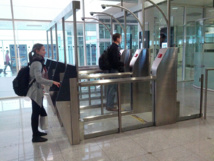The European Parliament's Civil Liberties Committee approved on Wednesday the project of creation of data bank on air passenger transportation (Passenger Name Records, PNR) in the EU, access to which will be open to national security and the European police organization Europol, reports EP press-service.
The project is part of the EU policy in the field of security and is aimed at combating terrorism and transnational crime. The database will store information about passengers leaving or arriving into the territory of the EU, including information on the passenger’s place of residence, the route of flight, the form of ticket payment, luggage and number of seats in the airliner. Also, the country of arrival can receive passenger data before they land there.
The project includes strict requirements for storage and transfer of PNR data to third countries.
Now the project of the EU databank on passenger air transport shall be submitted to a tripartite discussion in the European Parliament, the EU Council and the European Commission.
It seems that all the avia managing system prepares for small, but nevertheless significant changes. Earlier, the International Air Transport Association (IATA) recommended the world's airlines to adopt a new standards for carry-on baggage, which is less than the current sizes.
IATA experts believe that, with the new optimal size of a bag or suitcase – 55/35/20 centimeters - all the passengers of aircraft with capacity from 120 seats or more can comfortably place their luggage on the shelves. Basically, we are talking about the most common aircraft - Boeing-737, or line of A320 to A380.
- The new resolution is designed to make the best use of all storage space in the cabin. Even if the aircraft with 120 seats or more is fully loaded, each passenger will be able to place his hand luggage on board, - says IATA’s representative.
- There should be a single size for bags, which passengers can buy and be sure that it can be taken on the flight of virtually any airline, - senior vice president for IATA airports, passengers, cargo and security Thomas Windmuller comments the new initiative. At the time, the optimal luggage size proposed to be labelled in a special way: "IATA Cabin OK".
Windmuller noted that the recommendations do not forbid carry-on luggage of larger size. "IATA Cabin OK" Size is an orienting point, not a standard. The new recommended size does not replace restrictions on the size of carry-on baggage, determined by each airline individually. And, moreover, there are no plans to establish an industry standard everywhere," - he said.
Today, on international flights, many airlines allow luggage into the cabin more than recommended size.
source: europeonline-magazine.eu
The project is part of the EU policy in the field of security and is aimed at combating terrorism and transnational crime. The database will store information about passengers leaving or arriving into the territory of the EU, including information on the passenger’s place of residence, the route of flight, the form of ticket payment, luggage and number of seats in the airliner. Also, the country of arrival can receive passenger data before they land there.
The project includes strict requirements for storage and transfer of PNR data to third countries.
Now the project of the EU databank on passenger air transport shall be submitted to a tripartite discussion in the European Parliament, the EU Council and the European Commission.
It seems that all the avia managing system prepares for small, but nevertheless significant changes. Earlier, the International Air Transport Association (IATA) recommended the world's airlines to adopt a new standards for carry-on baggage, which is less than the current sizes.
IATA experts believe that, with the new optimal size of a bag or suitcase – 55/35/20 centimeters - all the passengers of aircraft with capacity from 120 seats or more can comfortably place their luggage on the shelves. Basically, we are talking about the most common aircraft - Boeing-737, or line of A320 to A380.
- The new resolution is designed to make the best use of all storage space in the cabin. Even if the aircraft with 120 seats or more is fully loaded, each passenger will be able to place his hand luggage on board, - says IATA’s representative.
- There should be a single size for bags, which passengers can buy and be sure that it can be taken on the flight of virtually any airline, - senior vice president for IATA airports, passengers, cargo and security Thomas Windmuller comments the new initiative. At the time, the optimal luggage size proposed to be labelled in a special way: "IATA Cabin OK".
Windmuller noted that the recommendations do not forbid carry-on luggage of larger size. "IATA Cabin OK" Size is an orienting point, not a standard. The new recommended size does not replace restrictions on the size of carry-on baggage, determined by each airline individually. And, moreover, there are no plans to establish an industry standard everywhere," - he said.
Today, on international flights, many airlines allow luggage into the cabin more than recommended size.
source: europeonline-magazine.eu



















